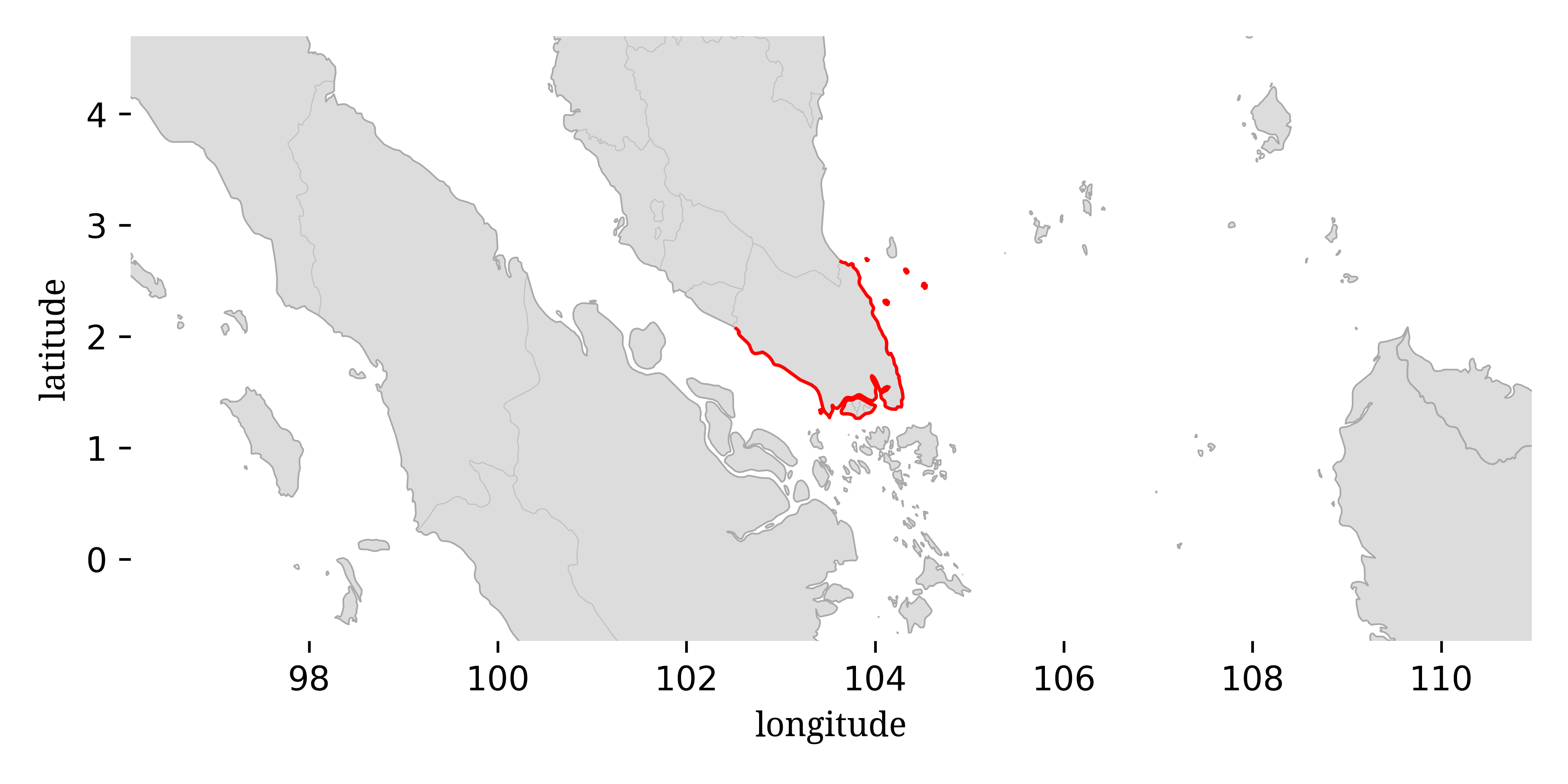
This guide is designed for identification “in the field” where you might be looking at live crabs by eye or through binoculars or from photographs. I will generally try to avoid characters that will require you to physically catch the crab, although I may mention a few for secondary verification. It does not include the more strict taxonomist-style characters that may only be visible under a microscope or via dissection. It is also assumed that the individuals are living, as death (and even capture) can cause dramatic color change.

This is a guide to the fiddler crabs of the southern tip of the Malaysian Peninsula, including Singapore and Johor, Malaysia. There are at least eight species present:
Gelasimus hesperiae has been reported as a rare occurrence in the past and Singapore would be considered about the easternmost extent of its possible range, although it should be noted that as it is all but identical in appearance to Gelasimus vocans, it could be that it has been underreported. Tubuca dussumieri has also been reported from Singapore, but again is either very rare or the reports are due to confusion with the closely related species, Tubuca paradussumieri (which itself appears to be rare in Singapore). For now I will exlude these two species from this guide.
A number of features can be used to distinguish among these species, but a good place to start is to look at the distance between the base of the eyestalks. Fiddler crabs tend to split into two groups, those with the eyestalks very close together (“narrow front”) and those with the eyestalks separated a bit more (“broad front”). Two of these species (Austruca annulipes and Austruca perplexa) are broad front species, while the others (Gelasimus tetragonon, Gelasimus vocans, Tubuca forcipata, Tubuca paradussumieri, Tubuca rhizophorae, and Tubuca rosea) are narrow front species. Note that the carapace between the eyestalks appears pinched together in the narrow front species, but more trapezoidal in the broad front species.
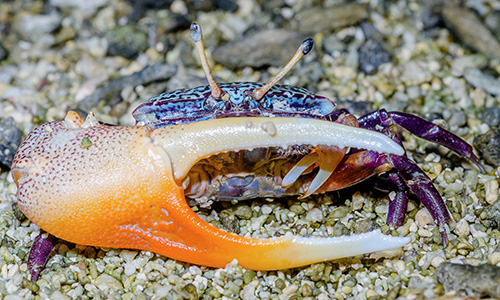
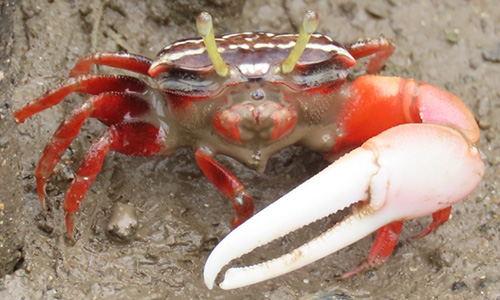
Austruca annulipes is a common, wide-spread species, and probably the most common species in this area. Generally, the carapace of Austruca annulipes tends to be a mix of black and white. The large arm of Austruca annulipes is generally orange or red, with some of the color frequently found on the hand of the claw as well.
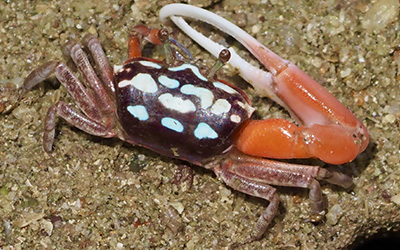
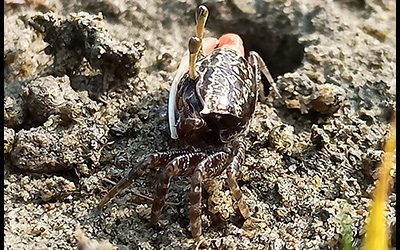
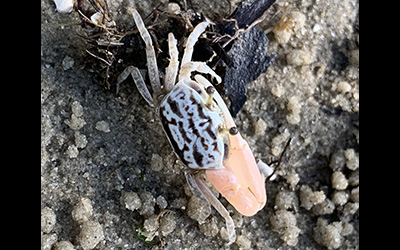
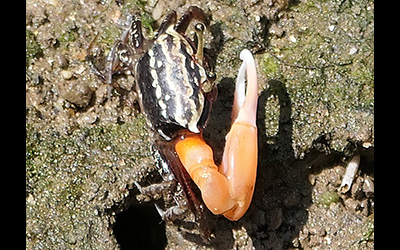
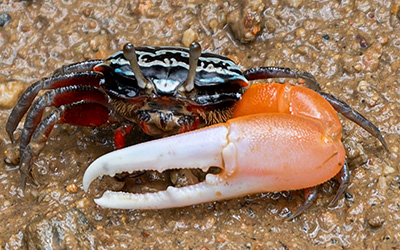
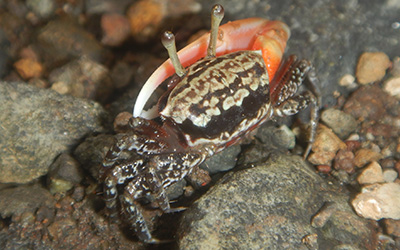
Austruca perplexa is likely rare in this area, although as it is very similar in appearance to Austruca annulipes, it could be that it has been underreported. Like Austruca annulipes, Austruca perplexa has a carapace that is generally black and white. Austruca perplexa frequently has a claw that is mostly yellow, with occasional solid white claws.
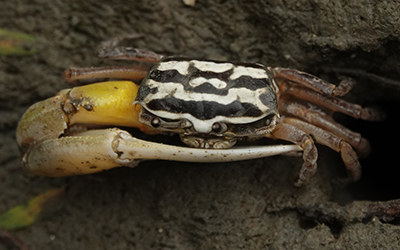

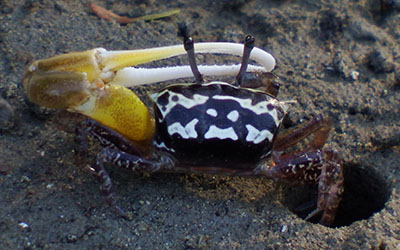
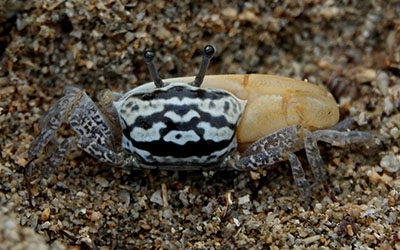
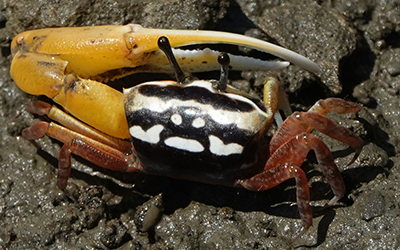
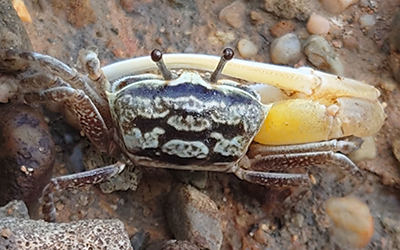
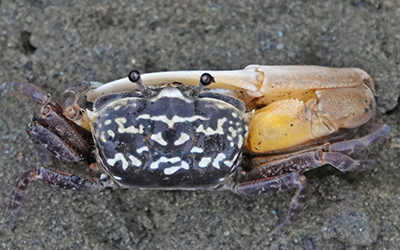
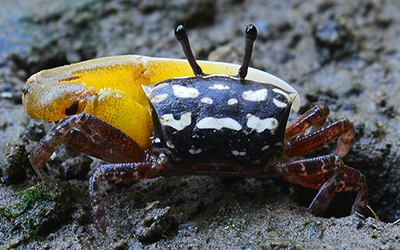
The primary difference between Austruca perplexa and Austruca annulipes is color, with Austruca perplexa leaning more toward yellows and Austruca annulipes leaning more toward reds. Paler forms without color are more difficult to tell apart.
Gelasimus tetragonon is a wide-spread species that is something of an oceanic island specialist, although it is occasionally found on continental shores. It usually has a predominantly blue and black carapace with bright red legs (which occasionally may be darker) and gray eyestalks. The large claw of Gelasimus tetragonon is usually orange, with a noticeably darker red spot near the base of the pollex, and a white dactyl. Gelasimus tetragonon frequently has brown spots on the top part of the hand of the claw.
Gelasimus tetragonon has a lot of additional variability. In some places the carapace can lighten so that there is almost no blue, just a cream or pale orange with black markings. The pattern of the colors on the carapace can vary from stripes or blotches to tiny spots.
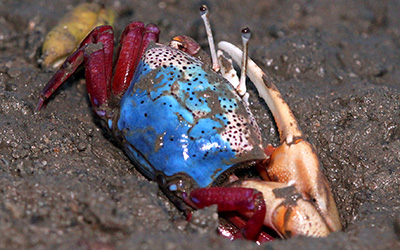
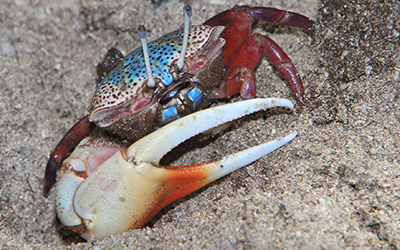
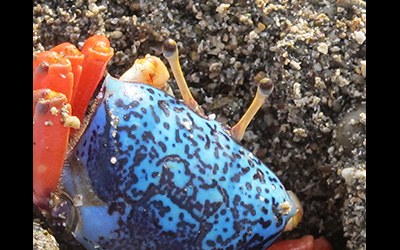
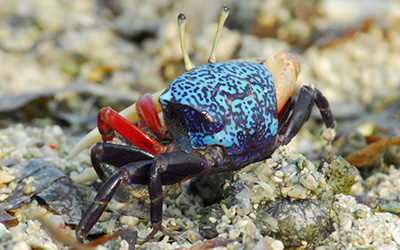
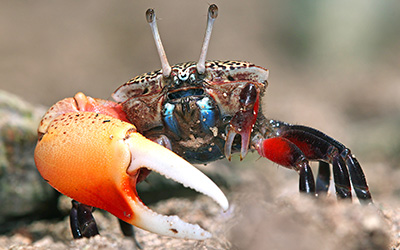
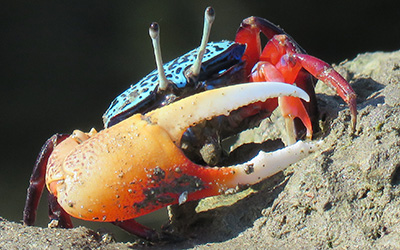
Tubuca rosea tends to be one of the more distinctively colored species. Its carapace is generally semi-translucent, frequently a pale blue or rose red (or both). Its limbs and large claw are generally rose red, with the fingers of the claw a bit paler.
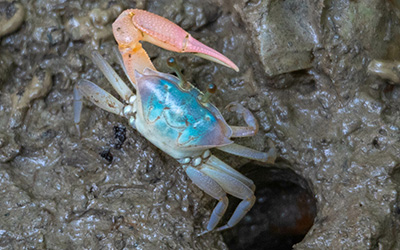
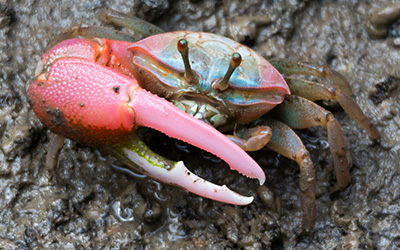

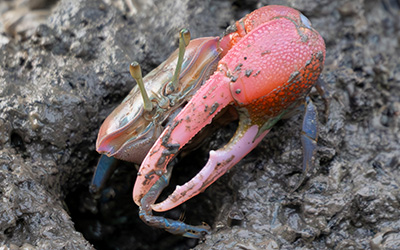
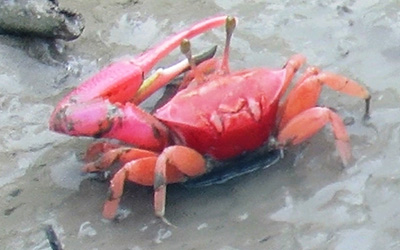
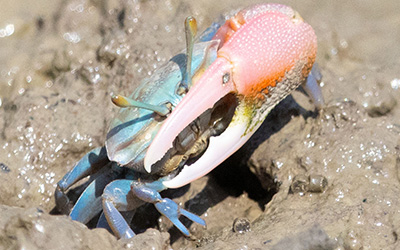
Tubuca forcipata is one of the more variable and confusing species, with multiple color forms that are not particularly similar to each other. One expert on fiddler crabs from the region has suggested that the name currently encompasses multiple, undescribed species being mixed together, but the formal work to determine if this is true and disentangle the various forms has not been completed at this time.
What I would refer to as the canonical form of Tubuca forcipata is a fiddler crab with a dark carapace with pale speckling (either white or pale blue) and a large claw where all or most of the hand is dark purple with the rest of the claw white. The claw is frequently heavily toothed and the tips of the fingers of the large claw often appear to come together as forceps, giving the species its name.
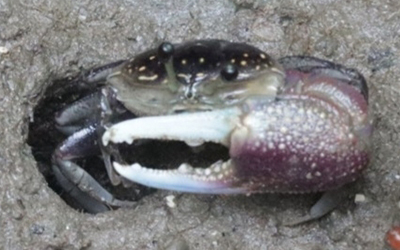
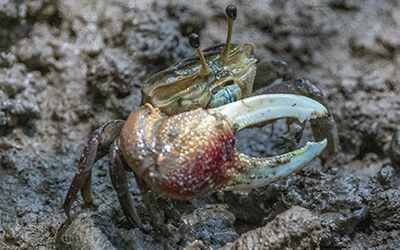
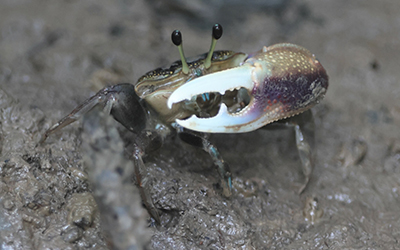
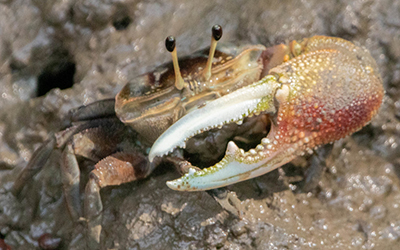
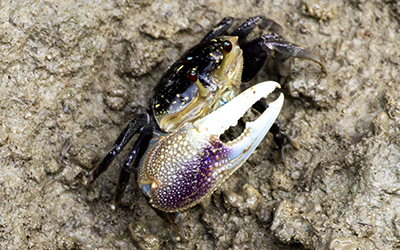
The second color form of Tubuca forcipata is completely different, with the crab a mix of black and bright red, generally with the black on the back half of the body and red on the front half, including the entire claw. The literature suggests that this bright red form is common in juveniles or yournger crabs of this species.
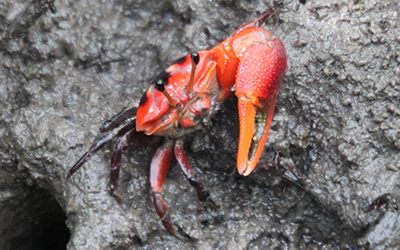
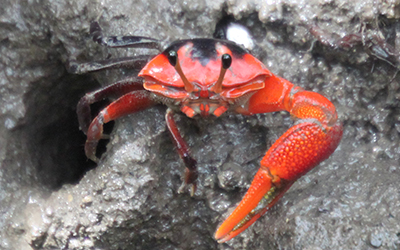
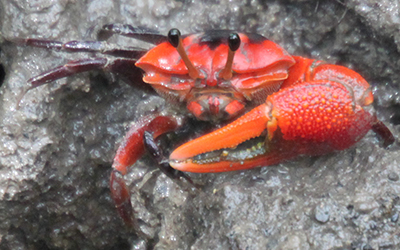
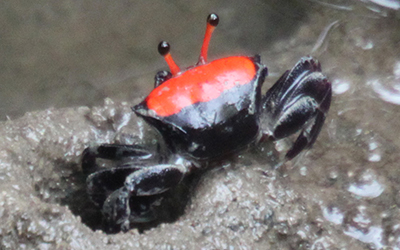
A third color form of Tubuca forcipata is vaguely in between the previous two, although not particularly similar to either of them. In this form, the carapace is generally black with large tan/beige patches toward the front, the legs are frequently pale gray, and the large claw has a dark red hand with orange fingers.
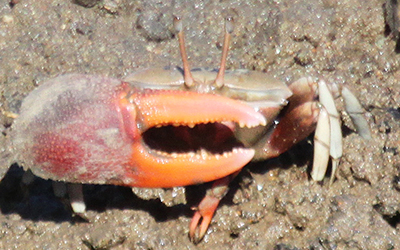

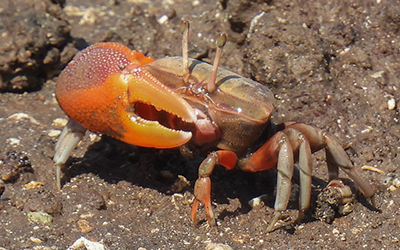
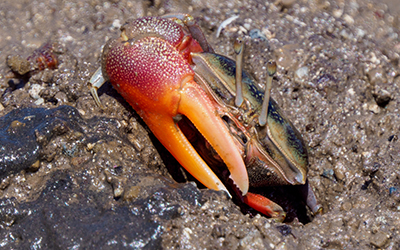
Are these all the same species? Maybe. It could simply be a variable species, the differences might represent age or developmental stage or regional variation. There are some additional patterns beyond color that separate these forms, particularly the first and third. The claw on the first form is notably toothier than the other two. The first and third form appear to have no geographic overlap, with the third form only appearing in the southeastern part of the Malay Archipelago (starting from Bali and including various islands further to the east and south), while the first form is only found further north and west (Borneo, Sumatra, etc.). Conversely, the black and red form (which has been suggested as representing a juvenile stage) overlaps with both of the other two in space, at least in part, as it has been seen from Bali (although not necessarily further south or east) to Singapore and the Malay peninsula.
Tubuca paradussumieri is a strangely variable species, but still frequently identifiable in each of its varying forms. In one common form, adults are generally a rather dull color, with a faded blue-tan carapace (sometimes light, sometimes dark) and generally yellow-tan major claw. The shape of the claw in this form is quite distinct with extremely long fingers relative to other fiddler crabs. The claw shape alone can be used to identify the species in this form.
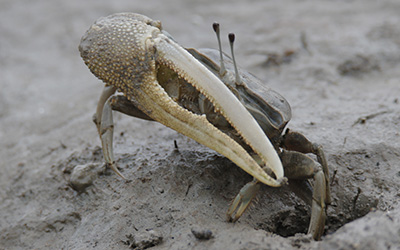
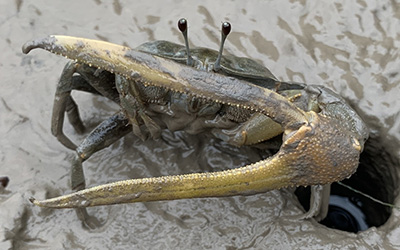
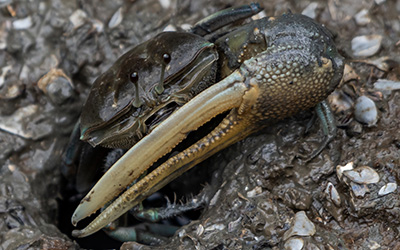
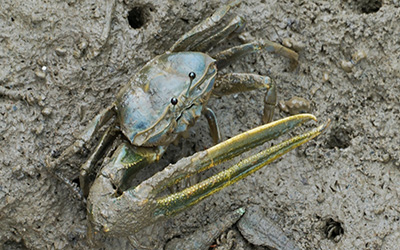
In contrast to the dull colors of these large adults, younger individuals in this species can be a brilliant cobalt blue, with much more typical-shaped claws lacking the overly long fingers. Some other related species from the genus Tubuca might also have a similar blue phase, so it is unclear how readily identifiable individuals of this shade are to the species level.
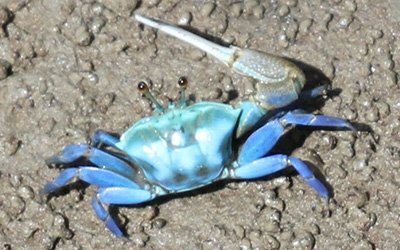
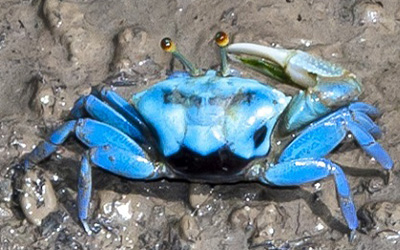
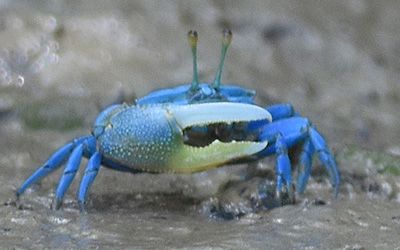
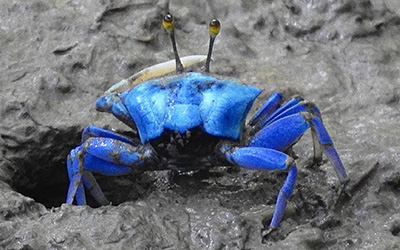
As mentioned earlier it is possible that previous reports of Tubuca dussumieri were actually Tubuca paradussumieri. Tubuca dussumieri has more distinct, less variable colors and would be relatively easy to identify if present.
Probably the second most common species in the region after Austruca annulipes, the carapace of Gelasimus vocans generally appears solidly colored or lightly marbled; the color is frequently green or dark brown or white. The lower finger of the claw is typically yellow or orange, with the upper finger white or pink. The species entirely lacks the reds and dark blues/blacks associated with the other narrow front species in the region.
The large claw has a distinct shape only found in the species of its subgenus. Specifically, the upper finger tends to be moderately broad, tapering smoothly to a point, while the lower finger will usually curve upwards with a characteristic wave on the inner surface highlighting one to two large teeth. Individuals with regenerating claws will often lack much of this shape, but the claw still looks readily different from other species in the region.

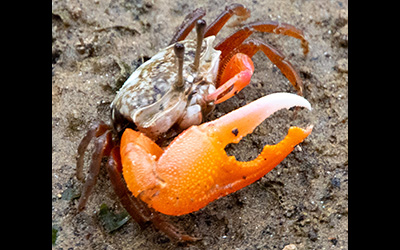

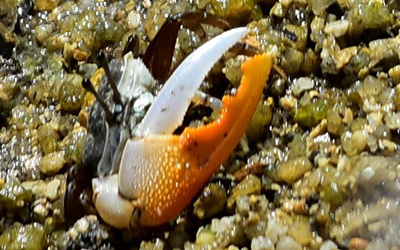
As mentioned earlier, there have been reports of an extremely similar looking species, Gelasimus hesperiae, from Singapore, which one would predict would be about the eastern limit of its range. Gelasimus vocans and Gelasimus hesperiae are extremely difficult to tell apart in the field, but an attempt to do so was included in the field guide to the Western Malaysian Peninsula.
Tubuca rhizophorae appears to be a generally rare species only found in limited parts of the southern half of the South China Sea. Its colors are fairly similar to those of Austruca annulipes, but it is easily distinguishable as a narrow front species.
Tubuca rhizophorae has a cream carapace black marbling in relatively large blotches. The hand and arm of its large claw are a dull reddish-orange, while the fingers are entirely white. In some cases the fingers may be particularly long and smooth and come together with a flatter edge.